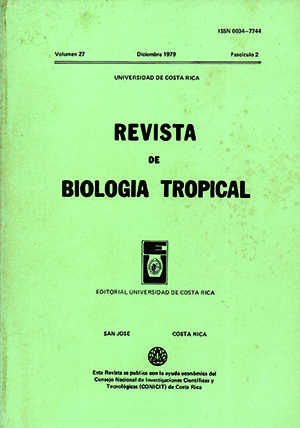Abstract
All the karyotypes of ten snake species of the family Viperidae from Costa Rica have a diploid number of 36 chromosomes, 16 macro- and 20 microchromosomes; females show an heteromorphism in the fourth pair. The karyological differences are restricted to the position of the centromere in the eighth chromosome pair and in the W-sex chromosome. The karyotypes of Bothrops asper, B. nigroviridis. B. schlegelii, B. nummifer, B. picadoi, B. nasutus and Crotalus durissus durissus are of an identical pattern, having a subtelocentric eighth pair and a submetacentric W-sex chromosome. The autosomal pattern of B. godmani and Lachesis muta stenophrys is similar to that of the above group, except that the W-sex chromosome is subelocentric. The karyotype pattern of B. lateralis is different from these in that it has a submetacentric eighth pair.
References
Baker, R.J., G.A. Mengden, & J.J. Bull. 1972. Karyotypic study of thirty-eight species of North American snakes. Copeia, 1972: 257-265.
Becak, W. 1965. Constituicao cromossomica e mecanismo de determioacao do sexo em ofídios sul-americanos. 1. Aspectos cariotípicos. Mem. lnst. Butantan, 32: 37-38.
Becak, W., & M.L. Becak 1969. Cytotaxonomy and chromosomal evolution in Serpentes. Cytogenetics, 8: 247-262.
Bolaños, R. 1971. Nuevos recursos contra el ofidismo en Centroamérica. 30 p. Departamento de Publicaciones, Universidad de Costa Rica. 2a edición.
Bolaños, R., & L. Cerdas. 1978. The production and control of anti-venoms sera. In. 15th. IABS Congress: Vaccinations in the developing countries, La Guadeloupe. Develop. biol. Standard., vol. 41, p. 109-116.
Bolaños, R., L. Cerdas, & J.W. Abalos 1978. Venenos de las serpientes coral (Micrurus spp.): Informe sobre un antiveneno polivalente para las Américas. Bol. Of. Sanit. Panam., 84: 128-133.
Bolaños, R., & J.R. Montero. 1970. Agkistrodon biJineatus Gunther from Costa Rica. Rev. Biol. Trop., 16: 277-279.
Brattstrom, B.H. 1964. Evolution of pit vipers. Trans. San Diego Soc. Nat. Hist., 13: 185-268.
Broadley, D.G. 1968. The venomous snakes of Central and South Afeica. p. 403435. In W. Bücherl, E. Buckley. & V. Deulofeu (eds.). Venomous animals and their venoms; vol. 1. Venomous vertebrates. Academic Press, New York.
Cohen, P., W.H. Berkeley, & E.B. Seligman, Jr. 1971. Coral snake venoms: In vitro relation of neutralizing and precipitating antibodies. Amer. J. Trop. Med. Hyg., 20: 646-649.
Gorman, G.C., & F. Gress. 1970. Chromosome cytology of four boid snakes and a varanid lizard with comments on the cytosystematics of primitive snakes. Herpetologica, 26: 308-317.
Gutiérrez, J.M., & R. Bolaños. 1979. Cariotipos de las principales serpientes de coral (Elapidae: Micrurus) de Costa Rica. Rev. Biol. Trap., 27: 57-73.
Hoge, A.R., & S.A. R.W. D.L. Romano. 1971. Neotropical pit vipers, sea snakes and coral snakes, p. 211-293. In W. Bücherl & E. Buckley (cds.). Venomous animals and their venoms. Vol. II: Venomous vertebrates. Academic Press, New York.
Klauber, L.M. 1971. Classification, distribution, and biology of the venomous snakes of Northern Mexico, the United States and Canada: Croralus and Sisrrurus; p. 115-156. In. W. Bücherl & E. Buckley (eds.). Venomous animals and thcir venoms. Vol. II: Venomous vertebrales. Academic Press, New York.
Klemmer, K. 1968. Classification and distribution of European, North African and North and West Asiatic venomous snakes; p. 309-325. In W. Bücherl, E. Buckley & V. Deulofeu (eds.). Venomous Animals and their venoms. Vol. I: Venomous vertebrates. Academic Press, New York.
Levan, A., K. Fredga, & A.A. Sandberg. 1964. Nomenclature for centromeric positions in chromosomes. Hereditas, 52: 201-220.
Levitan, A.T. 1968. The venomous terrestrial snakes of East-Asia, India, Malaya, and Indonesia; p. 529-576. In W. Bücherl, E. Buckley & V. Deulofeu (eds.). Vol. 1. Venomous vertebrales. Academic Press, New York.
Peters, J., & B. Orejas-Miranda. 1970. Catalogue of the Neotropical Squamata: Part I. Snakes. Bull. U.S. Natl. Mus., No. 297. p. i-viii+1-347.
Singh, L. 1972. Evolution of karyotypes in snakes. Chromosoma (Berl.), 38: 185-236.
Taylor, R.T., & R. Bolaños. 1975. Descripción de un método simple y económico para el estudio de cariotipos serpientes. Rev. Biol. Trop., 23: 177-183.
Taylor, R.T., A. Flores, G. Flores, & R. Bolaños. 1973. Geographical distribution of Viperidae, Elapidae and Hydrophijdae in Costa Rica. Rev. Biol. Trop., 21: 383-397.
Zimmerman, E.G., & W. Kilpatrick. 1973. Karyology of North American Crotalinc snakes (Family Viperidae) of the gene Agkistrodon, Sistrurus, and Crotalus. Can. J. Genet. Cytal., 15: 389-395.
##plugins.facebook.comentarios##

This work is licensed under a Creative Commons Attribution 4.0 International License.
Copyright (c) 1979 Revista de Biología Tropical


